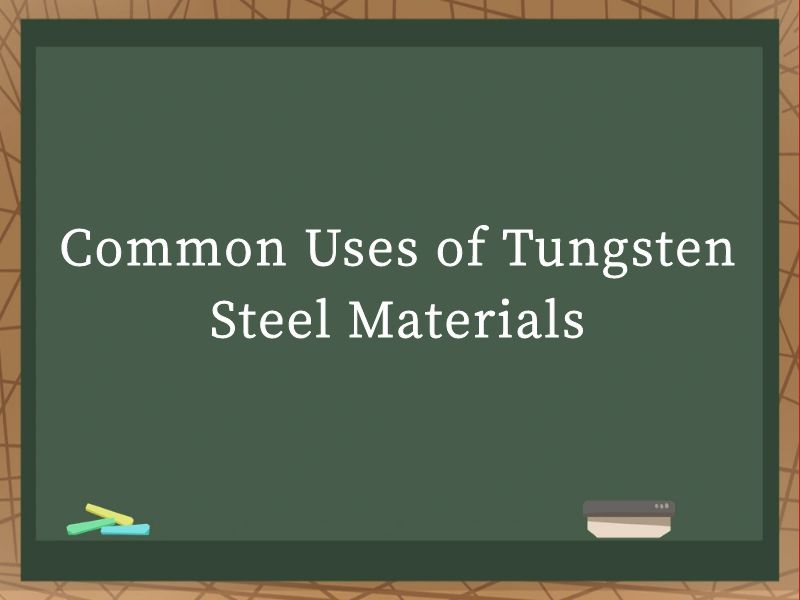JOURNALISM
- NEWS -
|
Common Uses of Tungsten Steel MaterialsCommon Uses of Tungsten Steel Materials.Tungsten steel, also known as tungsten carbide, is a hard metal alloy composed primarily of tungsten and carbon, with cobalt or nickel as a binder. Its exceptional hardness, wear resistance, and high-temperature stability make it a versatile material across various industries. This article delves into the diverse applications of tungsten steel materials, showcasing how they contribute to technological advancements and practical solutions in our daily lives.
Industrial Tooling and Machining One of the most prominent applications of tungsten steel lies in industrial tooling and machining. The hardness and wear resistance of tungsten carbide make it ideal for cutting and drilling tools. In the metalworking industry, tungsten steel drills, end mills, and reamers are essential for precision machining of hard metals such as steel and cast iron. These tools retain their sharpness longer than traditional high-speed steel or carbide-tipped tools, reducing the need for frequent tool changes and downtime. Moreover, tungsten steel is a critical component in milling cutters and lathe tools, enabling efficient and accurate material removal in both roughing and finishing operations. Its ability to maintain cutting edges at high temperatures ensures that it performs consistently under heavy loads and high-speed machining conditions. Mining and Construction Equipment The mining and construction sectors also benefit significantly from tungsten steel materials. The extreme durability and wear resistance of tungsten carbide make it an excellent choice for drill bits, mining picks, and other tools exposed to abrasive and high-stress environments. In mining, tungsten steel bits can withstand the wear and tear of drilling through hard rock formations, significantly extending tool life and reducing operational costs. In construction, tungsten steel components are found in road milling machines, concrete breakers, and tunneling equipment. These tools need to withstand the rigorous demands of breaking, grinding, and excavating hard materials. Tungsten steel's resistance to deformation and wear ensures that these machines perform reliably over extended periods, contributing to faster project completion and lower maintenance costs. Wear-Resistant Parts and Components Wear and tear are inevitable in many mechanical systems. Tungsten steel's ability to withstand friction and abrasion makes it an excellent material for manufacturing wear-resistant parts and components. In automotive applications, tungsten steel is used to make brake pads and clutches, enhancing stopping power and durability. The hardness of tungsten carbide ensures that these components wear evenly, providing consistent braking performance and extending their lifespan. Similarly, in aerospace and aviation, tungsten steel components are crucial for systems that experience high temperatures and extreme mechanical loads. Turbine blades, bearing surfaces, and sealing elements made from tungsten steel can withstand the rigorous conditions of high-speed flight and engine operation, ensuring the reliability and safety of aircraft systems. Medical and Dental Instruments Tungsten steel's precision and hardness make it an ideal material for medical and dental instruments. Surgical tools such as scalpels, scissors, and forceps benefit from tungsten steel's ability to maintain a sharp edge, reducing the risk of infection and improving surgical outcomes. The material's corrosion resistance ensures that these tools remain sterile and functional throughout their use. In dentistry, tungsten steel is used to manufacture drills, burs, and other instruments for dental procedures. The hardness and wear resistance of tungsten carbide enable these tools to cut through tooth enamel and bone efficiently, with minimal wear on the tool itself. This ensures that dental professionals can perform precise and effective treatments, enhancing patient care and satisfaction. Jewelry and Watchmaking Despite its industrial applications, tungsten steel also finds a place in the realm of luxury and fine craftsmanship. Its high density, hardness, and scratch resistance make it an attractive material for jewelry and watchmaking. Tungsten carbide rings, for example, are known for their durability and scratch-resistant properties, making them a popular choice for men's wedding bands. In watchmaking, tungsten steel is used to create precision components such as gears, springs, and bearing surfaces. Its ability to maintain dimensional stability and high hardness under extreme conditions ensures that watches perform accurately and reliably over time. Tungsten steel's resistance to corrosion and tarnishing also contributes to the long-term aesthetic appeal of luxury watches. Electronic and Semiconductor Applications The electronic and semiconductor industries also leverage the unique properties of tungsten steel. In the production of integrated circuits and microprocessors, tungsten carbide is used to manufacture cutting tools and polishing pads. Its hardness and wear resistance enable precise and efficient machining of silicon wafers, ensuring high yields and low defect rates. Tungsten steel's electrical conductivity and thermal stability make it suitable for use in electronic contacts and connectors. These components require high durability and reliability to handle the high currents and temperatures encountered in electronic systems. Tungsten steel's resistance to arc erosion and welding ensures that these contacts maintain consistent performance over their lifetime, enhancing the reliability of electronic devices. Energy and Power Generation In the energy and power generation sectors, tungsten steel materials play a crucial role in ensuring the efficiency and reliability of various systems. Turbine blades and wear rings in steam turbines and gas turbines are often made from tungsten steel due to its high-temperature stability and wear resistance. These components need to withstand the extreme conditions of high temperatures, high pressures, and high-speed rotation, making tungsten steel an ideal choice. Tungsten steel is also used in the nuclear industry, where its radiation resistance and high-temperature stability make it suitable for components exposed to radioactive materials and high temperatures. Control rods, shielding materials, and other critical components in nuclear reactors often incorporate tungsten steel to ensure safe and efficient operation. Sporting Goods and Recreational Equipment The versatility of tungsten steel extends into the realm of sporting goods and recreational equipment. In fishing, tungsten carbide sinkers and weights are highly valued for their high density and corrosion resistance. These properties enable anglers to achieve precise casting and better control over their fishing lines, improving their chances of catching fish. In golf, tungsten steel is used to manufacture golf club heads and shafts. Its high density and hardness contribute to increased clubhead speed and ball distance, while its ability to maintain structural integrity under high impact loads ensures durable and reliable performance. Tungsten steel's corrosion resistance also ensures that golf clubs maintain their aesthetic appeal and functionality over time. Conclusion in a Different Form By examining the various applications of tungsten steel materials, we can appreciate their significant contributions to technological advancements and practical solutions in our daily lives. From industrial tooling and machining to medical and dental instruments, from energy and power generation to sporting goods and recreational equipment, tungsten steel's exceptional properties make it an indispensable material across diverse industries. As we continue to explore new technologies and applications, the versatility and durability of tungsten steel will undoubtedly play a pivotal role in shaping the future. Whether it's enabling precision machining in the metalworking industry, improving the reliability of nuclear reactors, or enhancing the performance of golf clubs, tungsten steel stands as a testament to the ingenuity of materials science and its ability to transform our world. |


